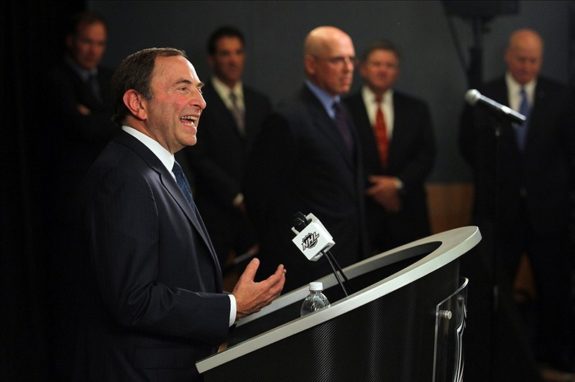
By Andrew Hirsh | Follow him on Twitter
Contrary to what anyone could have predicted back in 2005, the National Hockey League’s overall revenue has grown tremendously under the most recent collective bargaining agreement, reaching $3.2 billion last season—the most in league history. And yet, the majority of NHL teams continue to hurt financially, and very few are currently making real money.
The question begs: if the league has been successful as a whole, why are so many organizations struggling to make profits? While there’s no definitive answer to that question, much of this mess can be traced back to the salary cap.
When the league and the NHLPA were negotiating throughout the canceled 2004-05 season, the players proposed a cap structure that would have set the ceiling at $49 million throughout the entirety of that CBA, which expired on September 15. Had the owners accepted that plan—or one similar to it—most teams would have likely enjoyed healthy profits over the past several years.
But that offer was rejected, and the owners eventually made sure the cap would be directly tied to league revenue. Given that the NHL was in the midst of its worst financial period in league history, this seemed like a good idea at the time.
Now? Not so much.
The owners wanted their proposed structure in large part because they thought it would protect them from spending more than they could afford. Had business continued to get worse—as it had been in the years leading up to the last lockout—they didn’t want to pay their players based of an overly-inflated cap.
However, the owners’ plan accomplished exactly the opposite of what they wanted.
Since Bettman and Co. got their way, and since the league has grown so much financially, the cap has risen to ridiculously high numbers. This roughly 7 percent annual increase has led to a ceiling that’s eclipsed $64 million—quite a jump from the $49 million proposed by the players back in 2005.
These numbers make it difficult for many franchises to operate. Some struggle to claw to the cap floor, and getting there makes it impossible for them to turn profits.
Small market organizations like the Islanders, Coyotes, Stars and Panthers have seen business get worse over the past seven years, and in the process have had to pay more each season. No matter how good their products are on the ice, these teams simply can’t make money with the system that’s been in place.
Had the players gotten their way back in 2005, the floor would have been set at approximately $24 million. And yet, it had grown to more than twice that at nearly $50 million last year. Imagine how much easier business would be for these small market owners if the players got their way.
Of course, the proposal of a $49 million cap ceiling was a very high offer seven years ago; the 2005-06 season began $10 million below that at $39 million. But just two years later, the ceiling already rose above the players’ proposed figure and sat at $50.3 million. The projected ceiling for the 2012-13 season—had the current CBA been extended for that period of time—was roughly $70.2 million.
True, the players would be making far less had they gotten their way, but that’s not the point. The point is that the owners dug themselves in this financial hole. Doling out ridiculous contracts of 10+ years certainly haven’t helped matters, either.
This whole situation is very ironic. The owners got their way last time around, but it was the players that ended up benefiting from it. While the NHLPA needs to make some concessions this time around, we need to be clear as to who got us into this mess in the first place—and that would be the men writing the checks.
well a least the jets will get to play again and there are to many american team anyway.
Phoenix and Dallas are NOT small markets. They just don’t appear to be hockey towns.
Agreed.
I’m not sure what the excuse is for Dallas as they won the Stanley Cup but the Coyotes have yet to get to that level of success. Add in an owner who let the team bleed money then subtract the amount of fans who the Yotes might have had after the last three seasons but lost because of the uncertainty surrounding the team and then you’ll see why the team is how it is.